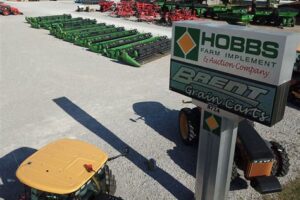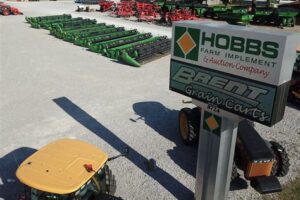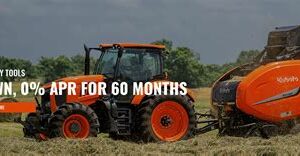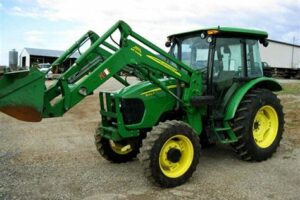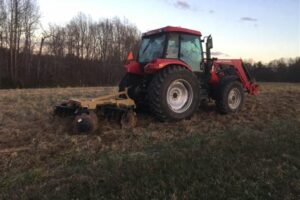Table of Contents
Discover the fascinating world of old farming equipment, transporting you back in time to a bygone era. Explore the ingenuity and craftsmanship of early agricultural machinery, from plows and harvesters to threshers and seed drills. Uncover the evolution of farming techniques and gain insight into the challenges faced by farmers of yesteryears. Delve into the rich history and significance of these relics, preserving the heritage of our agricultural past.
Old farming equipment, with its rustic charm and timeless appeal, is a testament to the rich agricultural history that has shaped our world. As we delve into the past, we discover a treasure trove of forgotten tools and machinery that once played a vital role in sustaining communities and feeding nations. From the mesmerizing sight of a vintage tractor chugging along the fields, to the intricate craftsmanship of hand-operated plows, each piece of equipment carries stories of hard work, resilience, and innovation. In this article, we will explore the fascinating world of old farming equipment, shedding light on their significance and the impact they have had on shaping the modern farming practices we know today.
The Evolution of Old Farming Equipment
In the early days of agriculture, farmers relied on their own hands and basic tools to cultivate the land. However, as the demand for food grew and technology advanced, the development of old farming equipment played a vital role in increasing productivity and efficiency. These antique tools, which are now considered relics of the past, allowed farmers to revolutionize the way they worked the land. Let’s explore the fascinating history behind some of these innovative inventions.
Hand Tools: The Foundation of Farming
Before the advent of mechanized equipment, farmers relied heavily on hand tools to perform various tasks. Simple implements like hoes, rakes, and shovels were indispensable for preparing the soil, removing weeds, and tending to crops. These tools required physical strength and endurance, as farmers would spend hours performing manual labor in the fields. Although these hand tools may seem primitive by today’s standards, they were essential for establishing the foundation of farming practices.
The Plow: A Game-Changing Invention
One of the most significant advancements in old farming equipment was the invention of the plow. The plow revolutionized the way farmers cultivated their land by allowing them to break up soil more efficiently and deeply. Early plows were made of wood, with a simple design consisting of a blade or share that could slice through the earth. Initially pulled by livestock such as horses or oxen, these plows were eventually upgraded to be hitched to tractors when engines became commonplace on farms.
The Reaper: Transforming Harvesting Practices
Harvesting crops by hand was an arduous and time-consuming process until the invention of the reaper. The reaper, a horse-drawn machine, mechanized the harvesting of crops like wheat, oats, and barley. It featured a cutting bar that would gather the crop and then tie it into bundles, significantly reducing the labor required for harvesting. This invention had a profound impact on farming, allowing farmers to increase their output and meet the growing demands of a rapidly expanding population.
The Thresher: Automating Grain Separation
Once crops were harvested, the process of separating the grain from the chaff was another labor-intensive task. However, with the introduction of the thresher, this process became much more efficient. The thresher worked by mechanically separating the edible part of the crop from the inedible husks and stalks. This innovation not only saved time but also ensured that valuable grains were not wasted. Threshers were typically powered by steam engines or later by tractors, further enhancing their productivity.
The Steam Engine: Powering the Revolution
One of the most significant advancements in old farming equipment was the introduction of the steam engine. Steam engines were utilized to power a wide range of farming machinery, including threshers, plows, and even irrigation pumps. This innovation provided a reliable and consistent source of power, reducing the dependence on animal labor and human effort. The steam engine marked a turning point in agricultural practices, enabling farmers to accomplish tasks on a much larger scale and with increased precision.
Horse-Drawn Seeders: Planting with Precision
Before seeders were invented, farmers would sow seeds by hand, resulting in uneven distribution and wasted resources. Horse-drawn seeders revolutionized the way seeds were planted by ensuring consistent spacing and depth. These machines would create furrows or holes in the soil, depositing the seeds at the appropriate intervals. The horse-drawn seeder significantly improved crop yields and allowed farmers to optimize the use of their land.
The Harrow: Perfecting Soil Preparation
Soil preparation is crucial for successful farming, and the harrow played a vital role in achieving optimal conditions. Harrows were used to break up clods of soil, level the ground, and remove weeds. These tools, typically pulled by horses or tractors, consisted of a series of sharp metal teeth that could be adjusted to different depths. The harrow’s ability to evenly distribute water, air, and nutrients throughout the soil greatly enhanced crop growth.
Horse-Drawn Cultivators: Taming Weeds
Weeds have always been a challenge for farmers, competing with crops for resources and hindering their growth. Horse-drawn cultivators were designed to combat this issue by mechanically removing weeds from the soil. These machines would cultivate the area between rows, uprooting and burying weeds, preventing them from reseeding and choking the crops. The introduction of cultivators significantly reduced manual labor and allowed farmers to devote more time to other essential tasks.
The Hay Baler: Efficient Forage Preservation
Preserving forage for livestock feed was a laborious process until the invention of the hay baler. The hay baler mechanized the production of compact bales of hay, straw, or other forage materials. This invention eliminated the need for manual bundling and tying, making it easier to handle and store large quantities of feed. The hay baler not only saved time but also improved the quality and longevity of animal feed, ensuring sufficient nutrition during the winter months.
Preserving the Legacy of Old Farming Equipment
While modern farming equipment has largely replaced the old, antique tools and machinery, they hold immense historical and sentimental value. Many farmers and collectors strive to preserve these artifacts, recognizing their significance in shaping the agriculture industry. Museums dedicated to showcasing old farming equipment offer a glimpse into the past, allowing visitors to appreciate the ingenuity and hard work that went into feeding generations before us.
In conclusion, old farming equipment represents a crucial era in agricultural history. From hand tools to steam engines, each invention played a vital role in improving efficiency, productivity, and ultimately, food production. These relics not only provide a fascinating insight into our farming heritage but also serve as a reminder of the incredible advancements that have shaped the world we live in today.
Old Farming Equipment: A Closer Look at the Tools That Shaped Agriculture
The history of agriculture is intertwined with the development of various farming tools that have greatly influenced farming practices throughout the centuries. These old farming equipment, although now largely replaced by modern machinery, played a crucial role in shaping the way crops were grown and harvested. In this article, we will take a closer look at some of the most significant tools that revolutionized agriculture.
The Plow: Unearthing the Origins of Farming
The plow, one of the oldest farming tools, was invented in ancient Mesopotamia around 3000 BCE. Initially made of wood and pulled by oxen, these early plows allowed farmers to till the soil efficiently, preparing it for planting. Over time, plows evolved with the introduction of metal blades and even tractor-pulled versions. The advancements in plow technology played a pivotal role in shaping modern farming practices, making it easier to cultivate larger areas of land.
The Scythe: Harvesting Crops with Precision
Before mechanical harvesters became prevalent, farmers relied on the scythe for harvesting crops. This long, curved blade attached to a handle allowed for precise and controlled cutting, minimizing damage to the plants. The scythe, introduced during the Iron Age, became a staple tool for farmers worldwide. It remained in use until mechanized farming methods took over, but its legacy as an efficient harvesting tool cannot be overlooked.
The Watering Can: A Delicate Drip of Sustenance
For centuries, the watering can was an essential farming implement that allowed farmers to provide precise amounts of water to their crops. Initially crafted from wood or metal, these containers featured a narrow spout that ensured controlled water flow. While modern irrigation systems have largely replaced the watering can for large-scale farming, it still finds its place in smaller gardens and urban farming situations where a delicate touch is required.
The Winnowing Fan: Separating Grain from Chaff
The winnowing fan was a vital tool for agricultural processes, particularly in the separation of edible grain from chaff. Farmers would toss the mixture into the air, allowing the wind to carry away the lighter chaff while the heavier grain fell back into a container. This simple yet effective method has been employed since ancient times, providing a valuable means of grain processing.
The Hand Seeder: Sowing Seeds with Precision
Before automated seeders took center stage, the hand seeder played a crucial role in evenly sowing seeds across fields. These handheld devices had attached canisters for holding seeds, which were then released in a controlled manner through small openings. The hand seeder simplified the labor-intensive task of sowing seeds and ensured consistent plant spacing, contributing to optimal crop growth.
The Sickles: A Cut Above for Harvesting
Sickles, with their curved blades attached to short handles, were extensively used for harvesting mature crops such as wheat or barley. This hand tool allowed farmers to swiftly and effectively cut through ripened crops. From ancient Egypt to medieval Europe, sickles played a crucial role in securing food supplies for communities and remain significant in certain traditional farming practices.
The Hay Rake: Taming the Fields
Developed in the 19th century, hay rakes helped farmers gather cut hay into uniform rows, facilitating the drying process. These manually operated tools featured long, curved tines that efficiently pulled hay from the ground while leaving behind debris. Although mechanized rakes have largely replaced their manual counterparts in modern farming, traditional methods often still employ hay rakes for small-scale or specialized operations.
The Corn Sheller: Streamlining Harvesting
As corn cultivation gained popularity, the corn sheller became an indispensable tool for simplifying the extraction of kernels from the cob. Initially, corn was shelled by hand, a laborious process. However, with the advent of mechanical corn shellers in the late 19th century, farmers were able to increase efficiency and productivity, allowing for large-scale corn harvesting and processing. The corn sheller revolutionized the way corn was harvested, making it more accessible as a staple crop.
In conclusion, old farming equipment has played a significant role in shaping agriculture throughout history. These tools, such as the plow, scythe, watering can, winnowing fan, hand seeder, sickles, hay rake, and corn sheller, have all contributed to the advancement of farming practices. While modern machinery has largely replaced these tools, their impact on agricultural development cannot be understated. Understanding the origins and functions of old farming equipment provides valuable insights into the evolution of farming techniques and the challenges faced by early farmers.
Old farming equipment has long been a staple in the agricultural industry, serving as reliable tools for farmers to carry out various tasks. These pieces of equipment, although considered outdated by modern standards, still hold immense value and significance in the field. From plows to harvesters, each piece of old farming equipment has contributed to the growth and success of agriculture over the years.
Here are some key points highlighting the importance of old farming equipment:
- Reliability: Old farming equipment has proven its reliability time and time again. These machines were built to withstand harsh conditions and heavy workloads, making them incredibly durable. Farmers could always count on their old equipment to get the job done, without worrying about breakdowns or malfunctions.
- Cost-effectiveness: Investing in new farming equipment can be a significant financial burden for farmers, especially those operating on a smaller scale. Old farming equipment offers a more affordable alternative, allowing farmers to access necessary machinery without breaking the bank. Furthermore, the longevity of these machines ensures that farmers can maximize their return on investment.
- Adaptability: Over the years, farming practices and techniques have evolved considerably. However, old farming equipment has proven its adaptability by remaining useful across different generations. These machines can be retrofitted or modified to meet modern requirements, ensuring that they remain relevant in today’s agricultural landscape.
- Historical significance: Old farming equipment holds a significant place in agricultural history. It represents the perseverance and hard work of previous generations of farmers who relied on these tools to cultivate the land. Preserving and using old equipment allows us to honor and appreciate the traditions and achievements of those who came before us.
- Simplicity: While modern farming equipment often incorporates advanced technology and complex features, old farming equipment boasts simplicity. This simplicity not only makes it easier to operate but also enhances its reliability. Farmers can quickly learn how to use and maintain these machines, reducing the need for extensive training or specialized knowledge.
In conclusion, old farming equipment continues to play a vital role in the agricultural industry. Its reliability, cost-effectiveness, adaptability, historical significance, and simplicity make it a valuable asset for farmers. Despite the emergence of newer technologies, old farming equipment should not be dismissed as obsolete. Instead, it should be celebrated and utilized as a testament to the ingenuity and resourcefulness of farmers throughout history.
Thank you for visiting our blog to explore the fascinating world of old farming equipment. We hope that this article has provided you with valuable insights into the importance and impact of these historical tools on agriculture. As we conclude, let us take a moment to reflect on the significance of preserving and honoring our farming heritage.
First and foremost, old farming equipment represents a crucial part of our agricultural history. These machines and tools have been instrumental in shaping the way we cultivate crops and raise livestock. From the simple hand tools used by our ancestors to the more advanced machinery of the 20th century, each piece of equipment tells a story of innovation and adaptation.
Preserving old farming equipment allows us to appreciate the ingenuity of those who came before us. It serves as a reminder of the hard work and dedication required to feed the world. By studying and understanding the evolution of farming technology, we can gain valuable insights into how we can improve agricultural practices today and in the future.
Moreover, old farming equipment also holds sentimental value for many people. For those who grew up on farms or have a deep connection to rural life, these tools evoke memories of a simpler time. They are a testament to the resilience and resourcefulness of farmers throughout history, who have played a vital role in sustaining communities.
As we look ahead, it is essential to recognize the importance of preserving and showcasing old farming equipment. Museums, historical societies, and dedicated individuals all play a vital role in this endeavor. By documenting, restoring, and displaying these artifacts, we ensure that future generations can learn from and appreciate the legacy of our farming heritage.
In conclusion, old farming equipment represents a crucial aspect of our agricultural history and heritage. By preserving these tools, we honor the ingenuity and hard work of those who came before us. As we move forward, let us remember the significance of our farming roots and strive to cultivate a deep appreciation for the tools that have shaped our world.
Thank you once again for joining us on this journey through the world of old farming equipment. We hope you found this article informative and inspiring. Stay tuned for more fascinating insights into the rich history of agriculture!
Video Old Farming Equipment
Here are some commonly asked questions about old farming equipment:
-
What qualifies as old farming equipment?
Old farming equipment typically refers to machinery, tools, and implements that were used in agricultural practices several decades ago. This can include tractors, plows, harvesters, seed drills, and other equipment that was prevalent before modern advancements.
-
Where can I find old farming equipment for sale?
You can explore various options to find old farming equipment for sale. Online platforms such as auction websites, classified ads, and specialized farming equipment marketplaces offer a wide range of options. Additionally, visiting local farm equipment dealerships, antique shops, or attending farm equipment auctions can be fruitful.
-
Can old farming equipment still be used?
Yes, old farming equipment can still be used, depending on its condition and functionality. Many collectors, enthusiasts, and farmers who prefer traditional farming methods find value in using or restoring old equipment. However, it’s important to ensure safety precautions and maintenance practices are followed to ensure efficient and safe operation.
-
Are replacement parts available for old farming equipment?
Finding replacement parts for old farming equipment can sometimes be challenging due to the age and rarity of certain models. However, there are specialized suppliers, online forums, and even fabrication services that cater to the needs of vintage farming equipment restorers. It may require some research and effort, but it is often possible to source the necessary parts.
-
What are the advantages of using old farming equipment?
Using old farming equipment can offer several advantages, such as a connection to agricultural traditions and heritage, reduced reliance on modern technology, lower initial investment costs compared to new machinery, and the ability to work at a smaller scale. Additionally, some older equipment may be better suited for specific tasks or have unique features that are not found in modern counterparts.
Remember to always assess the condition and suitability of old farming equipment before purchasing or using it. Consult with experts or experienced individuals if you have any doubts or questions.

